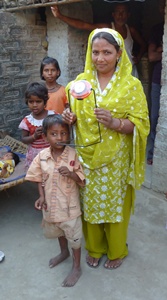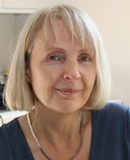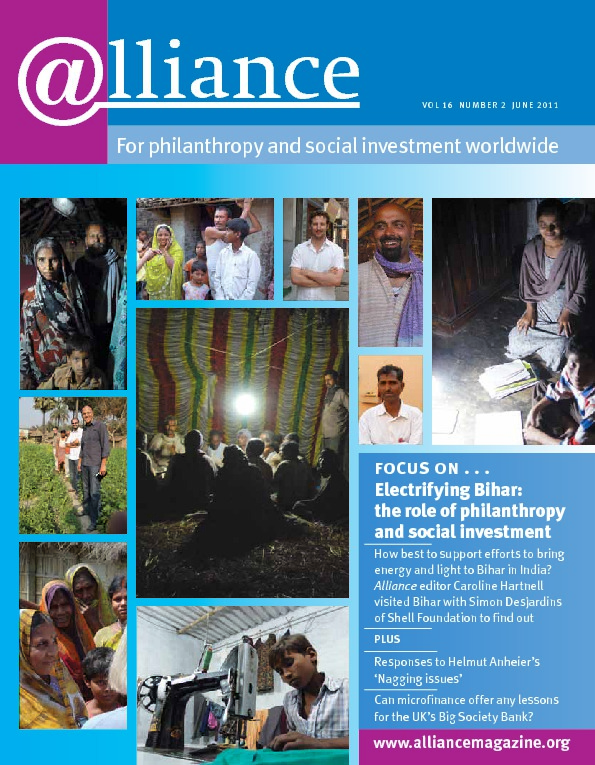Greenlight Planet is not short on ambition: their aim is to see kerosene lamps entirely replaced by solar lights. But their ideas about what is needed in the way of lighting and how best to distribute lamps to remote villages came through hard-won experience of things that didn’t work, as Anish Thakkar explained to Caroline Hartnell.
“We realized that having this trust-based relationship was crucial. The price doesn’t matter if people don’t trust you.”
How did Greenlight Planet come about initially?
We actually started in western Orissa in east India working with an international NGO on rural electrification. We were building a biodiesel generator to improve agricultural productivity and increase household income. However, what happened was that the villagers wired their homes from it and wanted the generator for light, not to increase agricultural productivity. But after two years the generator stopped working because of lack of know-how and of spare parts to fix it. We therefore changed tack and decided to focus on the provision of light, which could be done without infrastructure or generators. So that’s how we came to solar lights!
It was also while I was working in Orissa that I came to realize how big the problem is: something like half a billion people in India use kerosene lanterns for light at night.
We realized that providing solutions through aid money wasn’t going to solve it fast enough: we needed a solution that was self-sustaining and market-driven. This meant making lights that were cheap enough for a village family and reliable enough for them to want to buy it. As long as it made a small profit, we could scale, to an almost limitless extent.
The next question was how to reach the customer. We started market testing them in Uttar Pradesh. We went to some very poor villages in a van with a couple of boxes of prototype lights. The first couple of times we did this, people would just look at us in a funny way; they weren’t really very welcoming and we weren’t selling. But on one occasion, we went with an NGO field worker to his village, and that completely changed things. People were open and trusting and we sold more lights than we did in four or five trips to villages where we were unknown. So we realized that having this trust-based relationship was crucial. The price doesn’t matter if people don’t trust you.
In terms of lighting in India, what’s your ambition?
There are 500 million people in India using kerosene lanterns and 1.6 billion people in the world. Kerosene is expensive and smoky; it’s a health risk and a fire risk. And it produces so little light! One of the first things I noticed when we started doing our market tests was that about 20 minutes dark, the village would become quiet because there’s very little you can do. People just go to bed.
We’d like to see kerosene lamps entirely replaced by solar. Life improves significantly. Kids study more, more productive work is done at night, air quality is better, the chance of fire is removed, money is saved.
We’ve visited villages where 70 per cent penetration has been achieved in just a few months. Is there a danger that some of the more successful saathis (village-level sellers) will reach saturation point in their areas?
A saathi can often reach 60 or 70 per cent penetration in his home village in the first four or five months, then he will move on to the next village. As you reach a critical mass of users in a village, it snowballs and more people start buying as they see the all the houses with this bright white light. Many people now give a solar lamp as a wedding present. But saathis have an area of maybe 2,000 households so it will actually take a good amount of time to reach a significant saturation level in the whole area.
But we almost see solar lights as the entry point. When you go to a new village and you show the light, people crowd around. Today, they’re enduring life in the past, they know that city life is moving faster and faster ahead of them, and this is one of the few opportunities they have to get a piece of that. When a lot of homes have a Sun King light, the saathi becomes so trusted and credible in that village that he is in a good position to offer other products. He can go back and say, ‘this was great for you, now have you thought about water filtration or a clean cookstove?’ Once one of our products is in the house, the ability of the saathi to sell other products increases.
So you’re not worried about the sustainability aspect?
No, because it’s such a big market, and I think this is just the beginning of BOP product space. It’s a bit like e-commerce. Before Amazon and eBay came, you would buy online direct from the vendor. Now you can buy anything, and products that didn’t even exist before e-commerce became viable through this channel. When new sales channels connect a big enough market, product innovators will have to wake up and say, we should be looking for more solutions in villages. Once the market’s reachable, I think we’ll just keep accelerating.
At the moment, you’ve got 600 sellers, but your target is to have 30,000. What are the main barriers to that expansion?
Today we have 600 active sellers in our pilot areas, which represent about 8 per cent of the potential market in Bihar and Orissa – and Bihar and Orissa represent only 10 per cent of the off-grid lighting market for India! Scaling to 40 to 50 times our current size is the next challenge. So we’re really focused on getting ready for scale, putting the processes in place from a head office and corporate perspective. With 600 sellers, things can be managed with a small team, but we have to make everything from data systems to more robust HR policies function on a scale 40 times bigger.
One thing we’ll need is a lot more good managers. When we started, a lot of things were very intuitive because the managers were going through the whole experience from day one to the point where the model works. The question is, when you scale that up 20 times, how do you make it intuitive for managers? How do you enable them to make decisions that you’re confident are the right ones? This is about culture and training.
What about finance? Is that a barrier?
Well, the series A fundraising is going really well. The initial investors came from the sales force consultancy world – we wanted to use cutting-edge sales techniques and their support was invaluable – and they have put in 50 per cent of funding for the scaling up. Next, we want people who understand the social business space and also how to scale organizations. We’re also talking to some traditional institutional investors who are actually interested because it’s a socially relevant business.
Do you find fundraising a difficult process?
We’re selling an opportunity to invest in us and the investors need to feel comfortable with the company. The only frustration we have is that we’re trying to build the business and we also have to spend a lot of time talking to investors and trying to close funding. It’s straining our ability to run the business, so I’ll be glad when it’s over – which it very nearly is.
What about grant funding and debt? Do they have any part to play?
When we were looking at how to make these products really low cost, the R&D cost about $100,000 and that came from grants and awards for business plan competitions.
We are always going to be a very innovation-focused company. As we start putting this big operations plan in place and start reaching profitability – which is what most of our current funding is tied up in – we’ll have an incubator to test new innovations. Grant funding could provide reserve funds specifically for this.
We don’t have any debt funding, but I think it is a very useful thing for any start-up business. As a products business, we will always need a bit of working capital and raising equity for working capital isn’t the most efficient thing to do. I think debt has great potential, but the question is just what debt can we source at our current stage?
Bihar has been a sort of poor relation in India. Why did you decide to start off working there?
When we started off, we said, ‘let’s pick a place which is particularly hard, which, from what everyone tells us, is a very difficult state to get things done in in terms of governance and infrastructure and hiring, and let’s make something work there.’ If we can do that, we can be confident we can scale to places with the same or better conditions.
Maybe it’s a bit arrogant to deliberately pick a tough place, but it’s worked. I think it was a smart choice because a lot of the innovations and adaptations we have made to our model have been because of realities on the ground in Bihar, and they will work in other states.
Anish Thakkar is co-founder of Greenlight Planet. Email anish@greenlightplanet.com
 Greenlight Planet
Greenlight Planet
Launched in June 2009, Greenlight Planet’s key product is its Sun King portable solar light (pictured being displayed by a local family), which sells for 850 rupees ($17). It is designed to last for 10 years, working 16 hours a day on a single day of charge. It is three times brighter than a kerosene lamp and without the injurious health effects of kerosene.
Greenlight has been working in Bihar for almost two years. The distribution network consists of village-level direct sellers, called Sun King saathis (the word means ‘friend’), each of whom covers a group of villages (around 2,000 households), plus team leaders, district sales managers and regional sales managers. Saathis can be farmers, teachers, housewives; most work an hour or so each evening, often doubling the household income. Known and trusted in the community, saathis can sit down with families and show them how much light they will get in their home, and help them understand how much they spend on kerosene and how the new light will soon pay for itself. Full-time team leaders find, train and support the saathis, all of whom receive training and a ‘tool kit’ before they start.
Four hundred saathis now cover 10 per cent of Bihar. Towards the end of last year, Greenlight expanded into Orissa, where they are growing even faster. They are now selling 10,000 lights a month in all. Their headquarters is in Mumbai, with offices in Bihar and Orissa. They also have a presence in six countries in East and West Africa.
The big selling points of the Sun King lamp are:
- One-year warranty. Cheap solar lamps, often made in China, are available in shops in Bihar but they are unreliable. People want a high-quality product.
- Long battery life (three years).
People also want to be able to charge their phones; almost every household, even in Bihar, has at least one. People spend a lot of money and time on charging their phones. One study found that in rural areas of eastern India, people were spending more to charge their phones than they were on talk time. And they often have to walk considerable distances. In May, Greenlight launches a new lamp which includes a phone charger. They are also introducing lower-cost products that will be more affordable by the bottom 20 or 30 per cent on low incomes.
Greenlight started with a seed round of funding and a series A fundraising round is now under way. The initial investors were the co-founder of ZS Associates, the world’s largest strategy sales force consultancy (where Anish Thakkar used to work), and other principals of the company. They have also committed to investing 50 per cent of funding for the next round of funding.
For more information
http://www.greenlightplanet.com
 A day out with Greenlight Planet
A day out with Greenlight Planet
During our day out with Greenlight, we met saathis, team leaders, district and regional managers, and many Sun King customers.
 We met a group of seven saathis. All had owned Sun King lights before they became saathis. Sales in March ranged from 32 to 5 lights, but two had only started a month ago so were inexperienced. For the saathi who had sold 32 units (pictured), it was his only source of income. He works for an hour and a half in the morning when the village is busy before people leave for the fields or other work. Then he works from 7pm to 10pm when it’s dark and he can show the products. He comes from Bihar but had been working as an embroiderer in Delhi. There he was overtaken by industrialization, he explained. He felt he needed to invest in some machinery and approached his brother for help with the purchase. But his brother rubbished the idea and encouraged him to come back to Bihar to work as a saathi, which he did. Like all the other saathis, he has aspirations to become a team leader and perhaps go higher still.
We met a group of seven saathis. All had owned Sun King lights before they became saathis. Sales in March ranged from 32 to 5 lights, but two had only started a month ago so were inexperienced. For the saathi who had sold 32 units (pictured), it was his only source of income. He works for an hour and a half in the morning when the village is busy before people leave for the fields or other work. Then he works from 7pm to 10pm when it’s dark and he can show the products. He comes from Bihar but had been working as an embroiderer in Delhi. There he was overtaken by industrialization, he explained. He felt he needed to invest in some machinery and approached his brother for help with the purchase. But his brother rubbished the idea and encouraged him to come back to Bihar to work as a saathi, which he did. Like all the other saathis, he has aspirations to become a team leader and perhaps go higher still.
After talking to the saathis, we went with two of them to their villages and met many of their customers. Most had bought their lamps in the last few months; all seemed very happy with them. Some mentioned specific uses like enabling children to do homework in the evening or being able to work longer, but most just said they liked having the light. Some made it clear that the question ‘why did they like it?’ was a silly one! In one village we visited 100 out of 150 households had bought lights in four months –  and this was a village in theory connected to the grid. But one or two hours power a day at completely unpredictable times is simply not enough.
and this was a village in theory connected to the grid. But one or two hours power a day at completely unpredictable times is simply not enough.
At around 9pm, just as we were leaving the village, this man and his son (right) appeared. With their stall lit by a Sun King lamp, and their eggs all sold, they were on their way home from the market.
 A potential investor’s reflections on a day out with Greenlight Planet
A potential investor’s reflections on a day out with Greenlight Planet
The first things we look for in any investment are commercial viability and a good service that impacts the low-income community. We don’t look at just clean tech or environmental issues. So we looked at who Greenlight Planet’s main clients are and at the product. We’ve seen alot of solar lantern companies and we’ve seen products that haven’t passed quality tests.
What are you looking for in an investment?
In terms of distribution, Greenlight’s strategy works well for both social and economic reasons. At least here in Bihar, it’s targeting the people we want to reach and it’s also getting the product out in sufficient numbers.
Do you have any anxieties on the sustainability side?
There are a few things. First of all, we look at deals with about a five- to seven-year tenure. Beyond that, the market has to believe that the company has the potential to go further. My exit’s going to be another private equity group who are also looking at five to seven years, so I have to look at a 14-year time span, and try and predict where Greenlight will be then.
One of my concerns is what happens once a saathi has saturated his area?They’re building up a network and a distribution channel and they want to introduce other products. However, I don’t think some of the other products that I’ve seen will be as easily taken up as solar lighting. Take the cookstove, for instance. People we talked to in Jaipur had built stoves outside to avoid pollution indoors, which costs nothing. I question whether their rates of growth will be what they are expecting.
Do you see specific barriers to investment in Bihar generally?
The chief minister here is very pro-business. I get the sense that Biharis one of the faster growing states. But there are difficulties still. As we found with Husk Power, there are still some issues with getting your subsidy on time. I don’t think Bihar is the best place in India to do business yet, but I think there’s a growth potential.
If you do invest in Greenlight, are there specific areas you’d work on with them?
The core skill we offer all of our investment companies is our financialbackgrounds. With Husk Power, for instance, the idea was to build a financial model, train them up on it, and have them using it to help their company. We’d probably do something similar with Greenlight.
We also have Blue Orchard Finance and Blue Orchard Investments which do debt and equity in microfinance institutions. They have a number of connections in India and if Greenlight wants to use those to help finance products, we can explore that. We’re also looking at other companies that sell products that Greenlight could possibly sell throughtheir channel, and we would definitely facilitate those connections.
The last bit’s debt, which is pretty hard to come by in India. We’re looking at possibly doing a fund at the end of this year that would havea debt component to it. So if we invest equity, a different fund withinour Blue Orchard entity might be able to help them with debt.
Keith Allman is investment manager at Bamboo Finance. Email keith@bamboofinance.com





Comments (0)